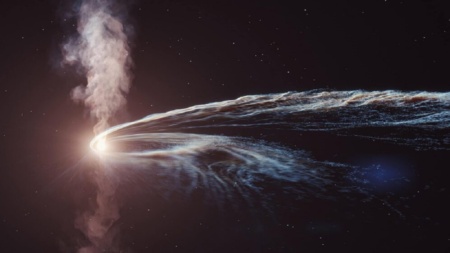
Such an event had not been observed for more than a decade: a burst of light from the center of a distant galaxy was bright enough to be seen 8.5 billion light-years away. The release of energy equivalent to more than 1,000 trillion suns was found by the Zwicky Transient Facility, a survey of the entire night sky at the Palomar Observatory in California.
“On Valentine’s Day this year, we found a mysterious source,” Igor Andreoni from the University of Maryland, the lead author of one of the two articles on this event, told about the history of the object observation. — “Strange is good for science. This means that you have a chance to learn something new.”
Over the course of several days, astronomers around the world pointed telescopes at the flare, observing it in X-ray, radio, and other wavelengths. It was extremely bright and looked like a gamma-ray burst, a burst of energy that can be detected with gamma or X-ray observatories. But this flash was noticed by an optical telescope. This is the first time that such a jet of energy has been detected in the visible part of the electromagnetic spectrum.
The immense brightness led astronomers to conclude that it was most likely caused by the star breaking apart due to tidal destruction. The star came too close to the supermassive black hole at the center of the galaxy and was torn apart by gravitational forces. Astronomers have already recorded dozens of similar events in recent years.
This case is unusual in that, as a result of the event, a huge stream of energy arose. At the same time, the material was ejected from the poles of the black hole at a speed close to the speed of light. It is believed that this jet became especially bright for observers because it was aimed directly at the Earth, making it visible in a wider part of the electromagnetic spectrum.
Course
Full Stack development
Learn on a free schedule to become a versatile specialist with Back-end and Front-end knowledge. Earn $1300 per month
REGISTER!
“We don’t know why, but sometimes when a star collapses, a very powerful jet of material is ejected,” Andreoni added.
To detect such fantastic phenomena, astronomers need telescopes that constantly scan large areas of the sky and record any sudden changes in brightness, which is the Zwicky Transient Facility. But such a technique records thousands of changes in brightness every night – this mountain of data needs to be refined to identify the most interesting objects. Andreoni’s group is looking for such data for very fast events in the optical range.
Sudden changes in brightness could potentially be caused by a supernova or the merger of two neutron stars. Further follow-up is needed to identify the specific event that triggered the outbreak. A supernova, for example, gets brighter over a period of several weeks, which is very fast by astronomical standards. But this event developed even faster, over days and hours.
The group reported this flare to the international community, urging researchers working at different wavelengths to also observe it. Data on the event were provided by 21 telescopes.
“When all the pieces of the puzzle were collected and put together, this amazing picture emerged,” Andreoni said. “We didn’t expect to find such a rare source, and certainly not in the optical range.”
Of the stars torn apart by black holes, only 1% produce such powerful emissions. Researchers are still unsure of their exact cause. When a star explodes and its matter is pulled into a black hole, the energy of that matter is converted into light. Magnetic fields and the black hole’s spin are thought to act together to eject material from its poles.
“We are talking about a mass that is thousands of times greater than the mass of the Earth, which is torn apart, spun up and launched at a speed close to the speed of light. This is a truly unique opportunity to study something that cannot be reproduced on Earth.”
This tells astronomers something about the environment around the black hole — that it’s not as dense because it lets optical light through — and shows that optical observations could be a useful way to detect these extreme events in the future.
“We’re talking about a mass that’s thousands of times the mass of the Earth being ripped apart, spun up and launched at near the speed of light.”
The need to quickly respond to such events encourages great flexibility in designing and planning the construction of telescopes. Instruments like Hubble or James Webb are heavily overburdened – there are more applications for telescope time than there is capacity to meet them. Observation times are carefully planned for years in advance and every last minute of observation is filled to the max. But at the same time, we need telescopes capable of responding to rare events within a few hours or even minutes.
It is difficult to safely and quickly change the direction of a space telescope, so Hubble and James Webb only occasionally participate in such studies. But recently built ground-based telescopes, such as the MASTER network, specialize in scanning the sky for gamma-ray sources and immediately moving autonomously to observe them.
According to Andreoni, the international cooperation of researchers working with different telescopes and the ability of the equipment to respond quickly were necessary to make this breakthrough in observations possible.
“It was extremely important for such a discovery. If we could not cooperate with other telescopes, we would not understand its meaning.”
NASA has shown a fascinating visualization of 22 of the most unusual black holes in our galaxy
Source: The Verge




